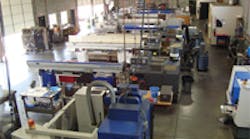Like so many frustrated dreamers, Mike Rosenboom would come home at night and vent to his girlfriend about work. As a contract machinist, Rosenboom savored his freedom and flexibility, but had little say about how operations were run. One night, his girlfriend stunned him with a suggestion: why not start a shop of their own?
The risk was daunting at the time. Nancy, whom he later married, had only $3,000 worth of savings to invest. They purchased a cutter and grinding machine that Rosenboom later determined would be utterly useless for their plans.
Through skill, shrewdness and resilience, the fledgling shop, which the Rosenbooms called MiniMachine, Inc., grew incrementally each year. Today, it employees 10 full-time workers and specializes in miniature precision components for the medical field.
Nearly 60% of MiniMachine’s business comes from producing cardiac catheter intervention devices, critical mechanisms in many heart surgeries. But, the shop has evolved into a precision products supplier for parts with holes anywhere from 0.005 to 0.035 in. in diameter — or roughly as thick as a human hair.
| • MiniMachine, Inc. Bend, Ore. www.minimachine.com • Number of employees — 10 • 2009 sales — N/A 2008 sales — $1.3 million • Markets served: Medical, government, communications, military |
Much of the work they do has to be viewed under a microscope. Many of the holes are only slightly larger than a flea. For this reason, MiniMachine has made a natural transition into providing parts for telecommunications systems as well as products for the defense industry. Over the next year, MiniMachine expects to receive Qualified Supplier List Manufacturer (QSLM) certification.
“We’ve always had a really strong quality system for our medical devices,” says Rosenboom. “Most of the things we need are already in place. All we need to do is tweak our quality system, so there’s ultimate traceability for each and every component.”
MiniMachine has a fleet of equipment specializing in high-production machining, including nine screw machines, each fitted with robotic loaders that allow for 24/7 production on long-running projects.
Rosenboom estimates that the company is still making payments on seven of those machines and they have no current plans for further capital equipment investment. However, throughout its history MiniMachine has been proactive in purchasing when a customer’s needs require it.
One of the more distinctive qualities about MiniMachine is its system for measuring production efficiency. In short, there are no metrics followed. Rather, the shop follows a series of distinct processes and philosophies.
Last year, MiniMachine did a gap analysis on production efficiency and found long setup times, late arrival of raw materials, lack of proper tooling and disorganized workstations, all of which combined to hinder its output efficiency.
The shop established a more structured form of order processing, more involved production planning that accounts for risk assessment, rigorous programming and job planning, greater structure to setup and validation among machinists, and finally production runs which see WIP inspections done on the fly.
“MiniMachine is a job shop, but we do large batches,” says Dan Beougher, a quality assurance manager. “That forces us to act much like a manufacturing organization.”
For this reason, the company set up a “radar chart” to measure its production efficiency. Shaped similar to a spider’s web, the chart breaks down eight categories (work order management; 5-S; QMS structure; dock arrival date to measure on-time delivery; safety; Kanban efficiency; first pass yield; and open CARS) with levels of success ranging between zero and 10.
Though firmly committed to running a tight business, Rosenboom savors the opportunity to take on challenging jobs — opportunities, he says, other shops don’t want to take. As an example, he cites a recent customer who requested titanium bone screws that would be used in orthopedic surgeries.
Upon examining the specs of what customer wanted, Rosenboom noticed it strongly resembled a standard wood screw — albeit a high-precision one — with a fancy driving head. Machining them would require MiniMachine to use thread whirling, a process it had never used before. The company spent $10,000 for a whirling head, plus an additional $3,000 for the cutter.
The venture contained a certain degree of financial risk, but also in process terms. Machinists needed to learn a sophisticated way of machining new products. But according to Rosenboom, running a successful shop means occasionally taking on calculated risks and embracing them.
“One of the problems that I see with [other shops] is their intrinsic unwillingness to take risks with customers,” says Rosenboom. “I think the ability of machine shops to ‘push the envelope’ with technology, and come up with answers to difficult questions, is a big force in innovation. If we don’t take risks to make our customers more competitive, they get hurt – and we get hurt.”
Taking on new applications requires a willingness to venture into the unknown. In MiniMachine’s case, it shows a shop — even one that produces tiny pieces — can take giant steps.






